
The Mediterranean vs American Diet
Your Complete Guide To Eating Like The Italians Do From An American Living In Italy

- Nathan Heinrich
- April 2, 2024
- Venice, Italy
When I moved to Italy from New York, in 2020, I had no idea how many poor American eating habits I was bringing with me and how my new life in this Mediterranean region would make me so much healthier – allow me to compare the Mediterranean diet to the American diet.
Although I grew up on a farm in California where we raised a good portion of our own healthy food, when I moved away to pursue my career in New York, I began to eat more and more of the typical American diet.
For years, I unknowingly absorbed some of the worst aspects of American food culture.
Since moving to the Mediterranean region, I have shed many of my unhealthy American eating habits such as fast food, mayonnaise on everything, massive portion sizes, and eating in front of the TV.
Along with the bad eating habits, I have lost weight along the way.
If, like me, you are interested in understanding the longer life span, better heart health, and reduced cancer rates associated with Mediterranean countries such as Spain, Italy, and Greece – continue reading.
In This Article:
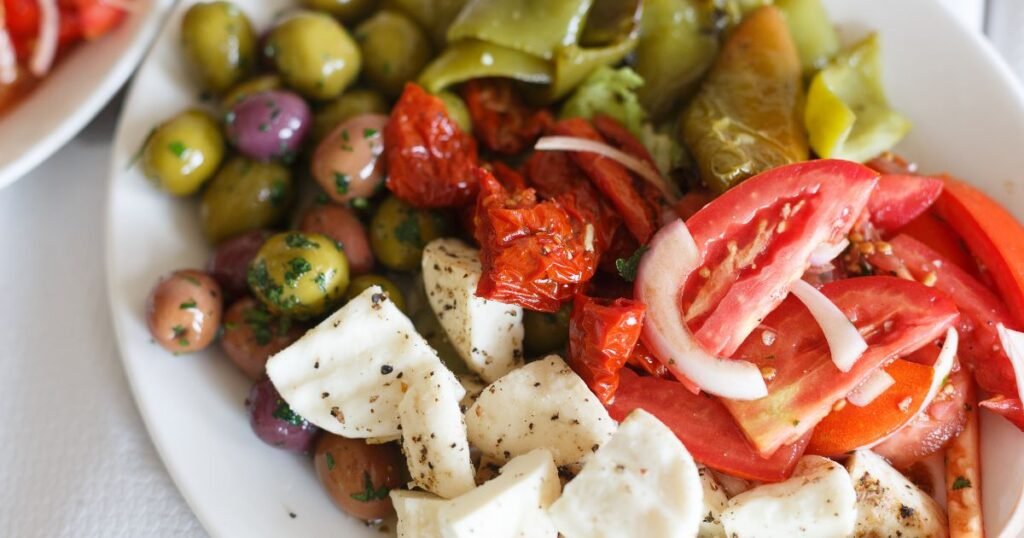
Why We're So Confused About Food
Although I could never really put my finger on why, with each passing year, I felt increasingly confused by the ever-changing diet scape and trendy food scene in the United States.
One month the Paleo Diet was in, and the next month everyone was talking about the Keto diet.
Before that, it was the low-fat diet and the Atkins Diet.
One diet told you to avoid fat and dairy at all costs while the next diet said you could eat as much of it as you wanted as long as you didn’t touch rice, bread, or potatoes.
If you live in a Western nation and have been exposed to the ever-deteriorating Western diet, you are most likely confused and frustrated by the shifting sands of trendy dietary guidelines like I was.
The Unhealthiest Diet On Earth
One would think that with the abundance of specific eating plans and claims of proper diet wisdom, the standard American diet would be the healthiest on earth – but nothing could be further from the truth.
In spite of our diet-obsessed culture, the US is one of the unhealthiest countries in the world.
The United States not only invented but also consumes more fast food than any nation.
They also have an extremely high sugar intake which is also the highest on the planet, according to a recent world report.
The United States also boasts an extremely high intake of red meat, a high intake of vegetable oils, and ultra-high processed foods.
The United States is a prime example of the Western diet gone terribly wrong.
What Happened To Our Food In America?
The problem for Americans, in particular, is that because they live in this messed up food culture, which has changed very slowly and consistently over the past 60 years, they have lost their objectivity.
Americans can no longer clearly see what giant corporations have done to take over and destroy their once-healthy food culture.
When I lived in New York, my eating habits were the worst of my life, but I was in denial and I didn’t realize just how bad they had become – until I moved to Italy.
In a recent episode of the I’m Moving To Italy podcast, I shared some of the worst habits I dropped like mayonnaise and Taco Bell, when adapting to life in Italy, and eating more healthy whole plant-based foods, fresh fish from the Mediterranean Sea, and healthy fats like olive oil.

Why Is The Mediterranean Diet The Best?
What makes the Mediterranean diet one of the healthiest diets and so different from other diets?
And why is it the best way for humans to eat according to scientific evidence?
If you’re like most Westerners and Americans you’ve been promised miracle quick-fix diets for years and you’ve rightly grown quite skeptical.
Here’s what I discovered after moving to Italy, the true Mediterranean diet is more a way of life than it is a restrictive set of rules and off-limit foods.
The best news for the diet-weary American or Westerner is that anyone can realize the health benefits of the Mediterranean diet without making any single food off-limits.
Who, What & Where?
Although not everyone is able to move to a Mediterranean country where the food quality is higher, and there are not fast food spots on every corner, the Mediterranean approach to food and lifestyle can be replicated almost anywhere.
Italians, French, Greeks, Spanish, Croatians, and Israelis all enjoy high life expectancy, and good health with overall fewer health problems than their American counterparts due to their very simple common sense approach to food and lifestyle.
They are the inventors of what modern dieticians and doctors have termed a “heart-healthy diet” and the “flexitarian diet”.
Mediterranean’s diets are full of fiber, and healthy monosaturated fats found in foods such as extra virgin olive oil, whole olives, almonds, fish, and seeds.
When it comes to animal products and animal proteins the traditional diet of those living in the Mediterranean region, includes healthy whole options such as feta cheese from sheep’s milk, buffalo milk mozzarella, and lean organically-raised meats, and fish.
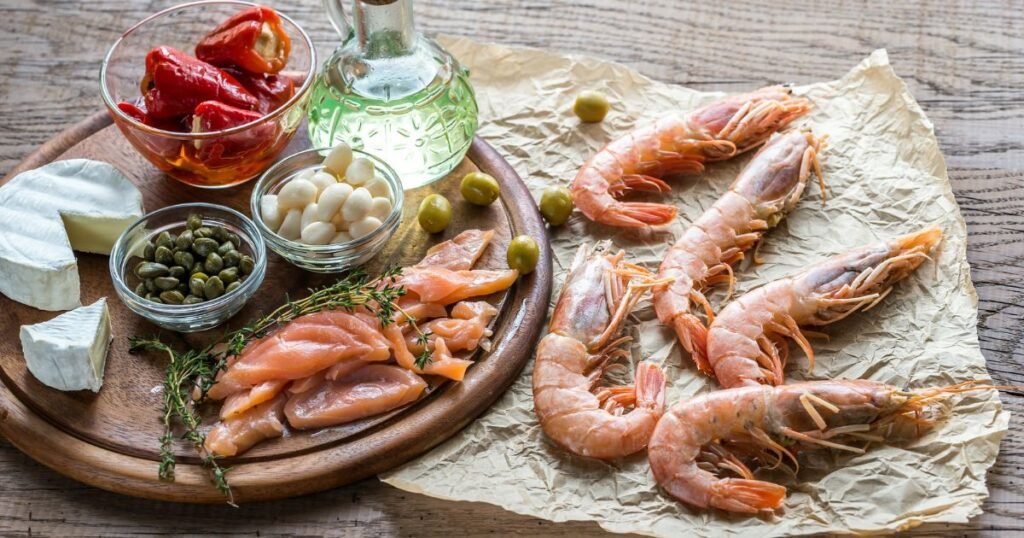
The Healthy Way Traditional Italians Eat
Since Italy is the only Mediterranean country I have ever lived in, it’s the only one I can speak about from first-hand knowledge.
But as it is almost completely surrounded by the Mediterranean Sea, is home to one of the world’s “blue zones” where people regularly live over 100 years of age, and is famous for its delicious and healthy cuisine, its one of the best perspectives from which to discuss the famous Mediterranian-type diet.
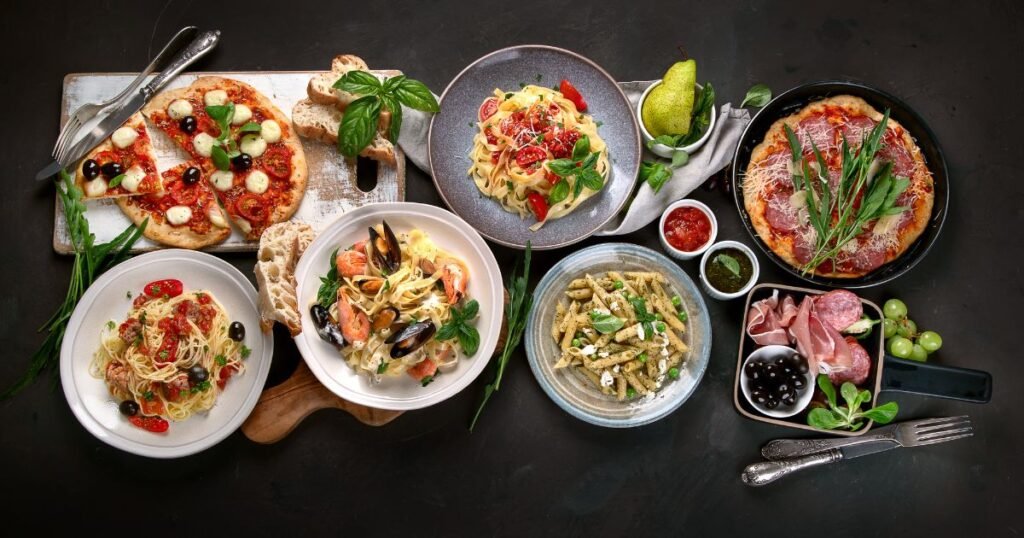
How Italians Eat
While what one eats is extremely important how one eats is also quite important.
Italians eat slowly.
They don’t rush through their meals.
In fact, the entire process of getting food onto the plate is a slow and careful process for Italians.
Allow me to explain.
If Italians have even the tiniest plot of land with a bit of sun you can be sure they will use it to plant a vegetable and herb garden.
Kitchen and herb gardens are still widely grown across Italy – for anyone who has ever gardened – you know it’s not a fast process.
For many Italians, this is the first of many slow steps taken before food ends up on their tables.
Italians who live in apartments in cities, are still inclined to get their hands on the very freshest food and produce.
Italian Markets & Grocery Stores
In nearly every Italian city, large or small, there are weekly markets overflowing with beautiful fresh fruits, lots of vegetables, herbs, cheese, meat, fish, and everything they need to eat healthily.
If you’ve ever visited one of these fabulous food and produce markets you would understand that this is yet another slow and methodical process – each item is hand-selected with great care.
Italian grocery stores are also a beautiful sight to behold.
With strict rules and restrictions in place for farmers and ranchers in Italy and most of the pesticides and herbicides banned, that are widely used in the USA, Italians can shop for food without the fear of what might be lurking in their groceries and potentially make them ill.
Once the food is brought home, from the farm, garden, fish seller, butcher, or market it is either carefully preserved for later use or is cooked with simple light ingredients.
By the time homemade Italian food finally makes its way onto the table, many countless hours have been invested into its very existence.
When you take such care to grow, buy and prepare food, it makes perfect sense to savor it slowly – and that is exactly what Italians do.
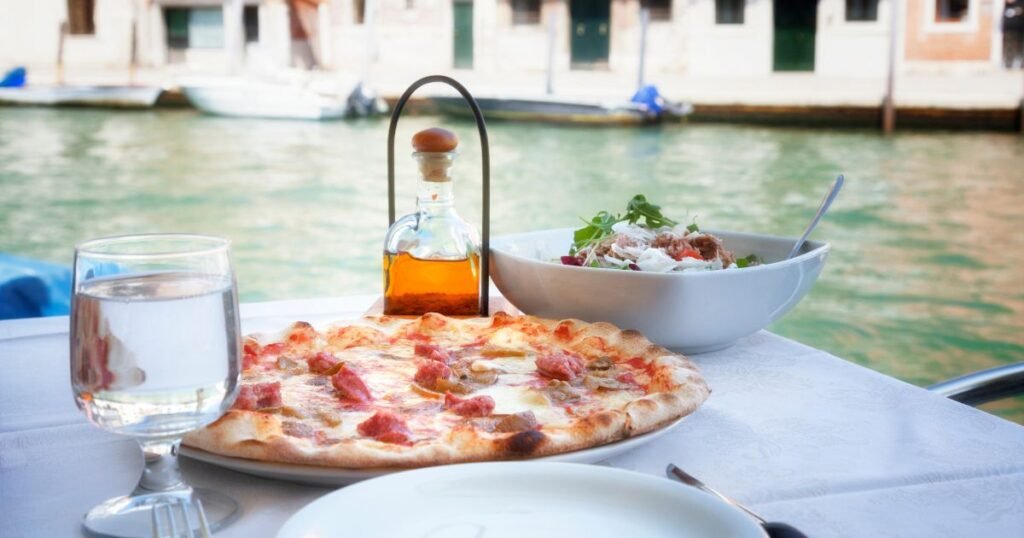
Where Italians Eat
Italian homes are much more compartmentalized than American homes.
Open floor plans are not a “thing” in Italy. Being able to see a TV from every corner of the house is not a priority for Italians, like is is for Americans.
Italians have a kitchen that is typically closed off by a door to the rest of the house – this way the cooking smells don’t travel through the home.
Often in the kitchen, there is a small breakfast table where lunch and breakfast are eaten.
Family dinners and meals are enjoyed at a large table in the dining room – yes, Italians still have dining rooms.
For special occasions, Italians will eat at restaurants but these are typically 2 or 3-hour events where food is served in courses – slowly.

Where Italians Do Not Eat
You will not find Italians eating in front of the TV. You will not find them eating in their car.
You will rarely find them eating at a fast food restaurant.
They do not eat while walking, riding, or traveling anywhere. Italians prefer to enjoy their meals seated and slowly.
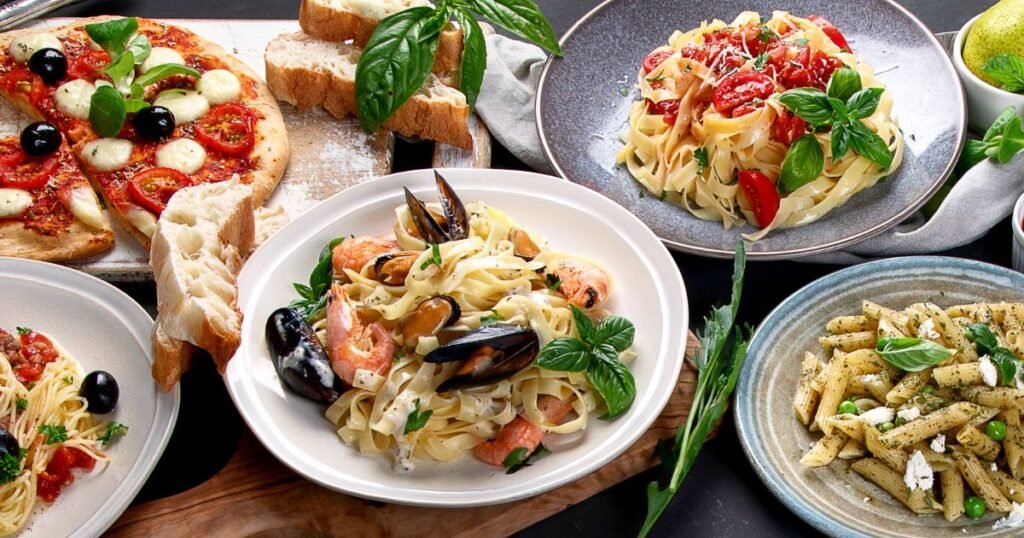
What Do Italians Eat?
Italians do not restrict themselves on what they eat but they do restrict how often and how much they eat.
It is quite common to see trim and fit Italians enjoying a weekly gelato. But their gelatos are usually one or two very small scoops made from very simple healthy ingredients.
Many Italians start their day at home with a cappuccino or espresso and a cornetto (a sweet brioche or croissant). Italians eat very small sweet breakfasts or pastries or cookies – or often none at all.
Italians are not afraid of carbohydrates – they often eat pasta and bread without guilt or fear.
Lunches are taken during the 2 or 3-hour-long “pausa” or break from 12:30 – 3:30 pm.
Lunches can be anything from a sandwich to a plate of pasta with a side of vegetables to a bowl of soup and a few slices of bread. In fact, bread is usually served with both lunch and dinner.
Dinners are the largest meal of the day and are rarely eaten before 8 pm. They always include vegetables in some form.
Salads - Fruit After Dinner - 10 pm Espresso
If there is a salad it is served after the main courses and lightly dressed in the tiniest amount of olive oil and vinegar or lemon.
Bread is on the table to be eaten with the meat, fish, or pasta course.
If white or red wine is served, it is only a single tiny glass with the meal – very few Italians have wine with every meal.
Fruit is often served after dinner before coffee.
Unlike their American cousins, Italians love strong black espresso – the last one being served at the end of dinner between 9 and 10 pm.
It is also worth noting that Italians are far more active than Americans.
Italians walk everywhere.
This makes a very big difference in their overall health.
Even though many Italians still smoke – many doctors believe that a sedentary lifestyle combined with a poor diet is far worse than smoking.
Real Health Benefits Of The Italian Diet
Italians and those who eat the Mediterranean diet tend to have significantly lower body weight and far fewer heart problems such as heart attacks.
Numerous studies by the American Heart Association have determined that the risk of cardiovascular disease, high blood pressure, and overall better health are directly associated with those who consume the traditional Mediterranean diet.
Blood sugar levels are also more easily controlled by eating the way Italians do.

Mediterranean For Life
There are a lot of misconceptions about the Mediterranean diet and how Italians eat.
But after examining the major differences between the Mediterranean diet compared to the American diet, hopefully, some of those misconceptions have been dispelled.
Americans tend to think that the Italian diet is made up mainly of pizza, pasta, wine, cannoli, and gelato – but the truth is, many Italians only eat pizza and drink wine a few times a week – usually on the weekend.
Sweets are enjoyed but in moderation.
Start Your Mediterranean Diet And Lifestyle Now
Italians eat a lot of bread and pasta, but they also eat a lot of whole grains, beans, fresh fruits, seafood, lean protein, lots of vegetables, and on special occasions a good local wine.
A huge part of the Mediterranean Italian diet is plant-based.
If you are at high risk of breast cancer or any other chronic diseases, and if you are struggling with weight loss – you may want to consider trying the world’s oldest and most tested diet – the Mediterranean diet.
It has transformed my life and it can do the same for you.
Read More About Italian Culture & Travel


Dreaming of Moving to Italy?🇮🇹 - Get this FREE podcast & be INSPIRED by someone who moved from New York to Italy in 2020!
*By signing up for this Podcast you’ll also be joining our mailing list through which we will keep you up to date on all things Italian! We never sell your information and you can easily unsubscribe at any time.
Share This Post
Author Info:

Nathan Heinrich
Nathan is a writer, designer & horticulturist. He is the founder and Editor-in-Chief of "All Roads Lead to Italy" Magazine & host of the Top-10 Travel Podcast, "I'm Moving To Italy!". Nathan was born and raised in a 6th generation farming family in Northern California, he is currently, a dual Italian citizen, living in the Prosecco Valley of Northern Italy, near Venice.
Follow him on Instagram, YouTube and other social accounts.


